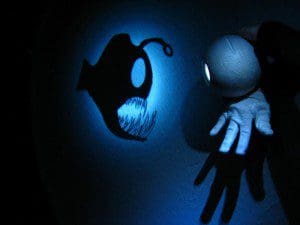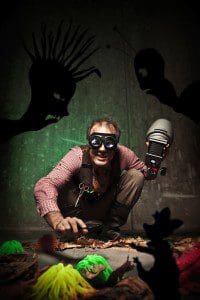
Alvin Sputnik: Deep Sea Explorer, showing through August 28 at the Underbelly as part of the Edinburgh Fringe Festival, takes place sometime in the near future. Global warming has caused sea levels to massively rise, and the remaining humans live in rickety stilt houses perched atop skyscrapers. The performance’s opening sequence shows our hero, Alvin Sputnik, at the bedside of his love, Elena. He sings her a simple song on his ukulele as her soul (a point of light) flies out the window and into the ocean. Alvin is despondent, until he sees an ad on television calling for volunteers to dive to the ocean floor on a dangerous mission, one with the potential to save humanity. With nothing to lose, he straps on a diving suit and heads down, hoping to find Elena.
Creator Tim Watts serves as narrator, puppeteer, actor and bard. Evoking the porthole of a submarine, a circular white screen at center stage is rendered alternately transparent or opaque, depending on where the light is coming from. At times animated sequences are projected onto the screen; sometimes we see Watts moving behind the screen, his face illuminated by a headlamp. By the same token, Alvin is portrayed in a variety of ways — sometimes as a cartoon, sometimes as a shadow behind the screen, sometimes as a puppet (or several different puppets), and sometimes by Watts himself.
The puppets are simple. Watts dons a white glove and tucks one finger up behind his palm to create a two-legged, two-armed figure; in the other hand he holds a Styrofoam sphere with a light inside, signifying a diving helmet. At one point, as Alvin swims ever deeper, a whale swallows the point of light representing Elena’s soul. The whale and Alvin swim side by side for a few happy moments, before an unfortunate belch sends Elena hurtling back into the oceanic depths. At first the whale is animated, but then Watts brings out an illuminated whale-object (stuffed animal? puppet? lantern?) from behind the screen and runs back and forth on the stage, with the Alvin-puppet in one hand and the whale-puppet in the other, weaving them around one another in a watery dance, making joyful burbling noises.
Swamp Juice, also at the Underbelly through August 28, has the same regressive quality as Watt’s show—it’s less like watching a performance, and more like watching a boy playing with odds and ends in the attic on a rainy afternoon. As homespun as Alvin Sputnik is, with its simple animations, paper buildings and hand puppets, Swamp Juice is even simpler. Creator Jeff Achtem looks a bit like the Lorax. He wears purple leggings and a tweed waistcoat. His thinning hair sticks straight up. All the puppets Achtem will use are in plain sight, strung across the stage on a clothesline, but none of them seem likely characters, or even coherent objects. They simply look like bits of cardboard and cloth, old socks and mops and glitter and pipe cleaners. The stage resembles a first-grade classroom in the aftermath of an art project.

At the beginning, Achtem slides a sock with a piece of foam sewn into it onto his arm; over that goes a glove attached to what looks like a shapeless cardboard blob. We can’t imagine what he could be thinking. Then he sits down on a suitcase, flings his arm above his head, flicks on a light behind him, and his forearm and hand are transformed into a snail, complete with a moveable pupil. (“He can see you!” mutters Achtem, gleefully.) Swamp Juice turns on these delightful moments, when something that makes no sense in three dimensions reveals its form and meaning through a simple shift in perspective. The show follows a slightly sadistic human shadow puppet as he captures the creatures of the swamp one by one, moving up the food chain—snail, carnivorous-looking snail, then a snake. His ultimate prize is the “birdie,” who he chases from her nest and finally captures—only to be eaten himself by the swamp monster. For the show’s finale, Achtem hangs a sheet across the entire stage. With brusque self-assurance, he pushes props into audience members’ hands — fake reeds, mops, koosh balls. He gets one middle-aged guy up from the audience and dresses him up as a sort of underwater mountain, cajoling him into the costume (“you’ll like it, you’ll like it”). He gets everyone to hold up their props and wave them back-and-forth. Then a bright light comes on at the back of the house, projecting our underwater swampscape onto the screen. Achtem himself staggers awkwardly across the knees of the fourth-row audience with a bird puppet, making it swim (“swim Birdie, swim!”) among the reeds and weeds and jiggling swamp creatures.
Why is it, when we’re inundated with slick, over-produced entertainment, when most of us seem willing to accept the lifeless, dull-colored, bubble-faced aesthetic of 3-D animation, that shows like Alvin Sputnik and Swamp Juice can draw sold-out, multi-generational crowds at the Festival? The youngest of the children in this audience grew up playing video and computer games almost from infancy. Present them with a toy car or a wooden ship or a simple stuffed animal (one that doesn’t speak English, giggle, and hug back) and they’d probably be bored. Alvin Sputnik and Swamp Juice offer two things we hardly ever get: the sweet authenticity of home-made materials and props, and the juicy thrill of watching something unfold that isn’t wholly settled and canned. Both pieces are happenings as much as they are puppet shows—Alvin Sputnik, because the characters and props (and some of the animations) are created right before our eyes, and Swamp Juice because of the massive risk involved in that degree of audience participation. Such work inspires something like nostalgia for nostalgia—not longing for something we’ve lost, but longing for something we never had.
